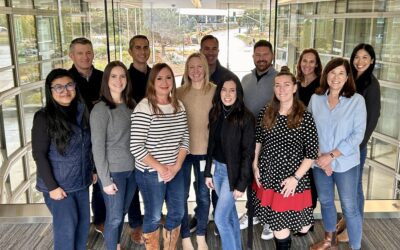This article originally appeared in The Healthy, High-Performing Cultures Issue of Performance Matters Magazine. To request a print or digital copy of the magazine, click here.
Whether we realize it or not, maxims—those pithy statements we learn along our leadership journey—can shape our behaviors. As organizations grow and evolve, it can be tempting to buy into commonly held beliefs about how a business should operate. In every growth journey, an organization outpaces the underlying systems, processes, and structures that supported past performance. Yet in responding to the need to fill this organizational gap, leaders may rely on old beliefs, patterns, and stories—at times to the detriment of the organization’s growth potential.
We can dispel these traditional-yet-limiting maxims by advocating for research-informed, people-centered approaches to cultivating healthy, high-performing organizations. Let’s explore five reframes to common myths that may inhibit the evolution of your organization.
“The best teams have the best performers.”
You work to answer many key questions for your business. How can you build teams with more rock stars? What is the talent you’ll need for the strategies of tomorrow? How can you consider diverse viewpoints?
At its core, you’re asking, “What does it take to build the best, most effective teams?”
Steve Jobs is quoted as saying, “The secret of my success is that we have gone to exceptional lengths to hire the best people in the world.” Many believe that to have the best teams, you need the best people.
To see if this maxim holds true, Google conducted hundreds of interviews, explored hundreds of skills, and reviewed hundreds of active teams. Yet they concluded it’s not that the “best” people make the best teams—it’s that the best teams are the ones with the most trust and safety.
- There was little to no correlation with common factors like location, decision making, extroversion, individual performance, workload, seniority, size, or tenure.
- The team makeup matters less than how the team members interact.
- Psychological safety was the most important of the five dynamics that Google surfaced.
Rather than building teams with more rock stars, consider how you might model and set a climate of curiosity and safety. (Click here to learn more about team effectiveness and psychological safety.)
“Create formal programs for reward and recognition.”
Contrary to many long-held beliefs, you can meaningfully recognize someone with informal, simple, in-the-moment praise—without a formal recognition program.
Shawn Achor, author of Big Potential and world-renowned expert on positive psychology, says, “Praise is actually a renewable resource and primes the brain for higher performance. The more you can authentically shine praise on everyone in your ecosystem, the more your potential, both individually and collectively, rises.”
It takes 30 seconds to live this insight:
- Start with authentic acknowledgement. “I saw what you did, thank you.”
- Connect the action to the recognition of a strength or talent. “That action says a lot about you. It’s clear that you _____.”
- Connect the action to the impact it had on others. “This is what it meant to the team: _____.”
Instead of relying on formal programs, seek to create accessible, informal opportunities for reward and recognition at your organization.
“Successful employees make it happen for themselves.”
In Big Potential, Shawn contends that nearly every attribute of our potential—including intelligence, creativity, leadership, personality, and engagement—is interconnected with other people. Success isn’t a marker of individual achievement or accomplishment. Instead, the people who succeed at work are those who can ask others for help and rally others to grow.
When we help others achieve success, we not only raise the performance of the group; we also exponentially increase our own potential. Making others better can take our success to the next level, because groups with mutual member support enable greater accomplishments than any individual could achieve alone.
It’s like jumping on a trampoline. Alone, you can only jump so high. Yet if someone jumps with you, and you time it right, they augment the potential energy and you experience a “super bounce” when, together, you spring up much higher.
Reject the old maxim and instead find positive, authentic influencers who support, reinforce, and make each other better. (This is what Shawn Achor calls a star system or constellation.) Define your success by asking, “How did I help the team succeed?” Surround yourself with people who give you a super bounce, rather than knock you down—and be a super-bouncer for others.
“Maintain work/life balance.”
Let’s unpack what is often referred to as “work/life balance.” Henry Ford popularized the eight-hour workday, but the concept is from the 19th century—when work and life were seen as mutually exclusive, in competition, and operating under different values or rules. These concepts are rooted in the mindset of a job as a transactional task performed in exchange for compensation.
However, the wants and needs of workers change as generations of people mature and others enter the workforce. In McKinsey Quarterly, five emerging personas of workers were explored, including what drives their engagement in the post-Great Resignation world. Surprise? Only one persona highly valued compensation as their primary factor in decisions.
Here’s what mattered most to the four other emerging personas of workers:
- Meaningful work
- Flexibility
- Reliable and supportive peers
- Support for health and well-being
- Sustainable expectations
- Caring and inspiring leaders
- Inclusive and welcoming community
- Safe workplace environment
The more we align personal values and organizational values, the more we can see that it’s the integration of work and life.
“You can’t teach an old dog new tricks.”
How we think about learning, intelligence, and our abilities has a direct and significant effect on our learning progress and our ability to improve.
When we believe that we can do and be better, according to our abilities and the effort we put in, we are embracing a growth-oriented mindset. Conversely, when we believe that we’re just not good enough or capable enough to learn, achieve, or do something challenging, we set ourselves up to fail…thus proving ourselves “right.”
According to Carol Dweck, PhD, professor at Stanford University and author of Mindset: The New Psychology of Success, mindset is a self-perception that’s either fixed (“I am a great speaker” or “I am a bad speaker”) or growth oriented (“I know I can develop further” or “This isn’t my area of expertise, but I know I can learn”).
Here are some benefits to having a growth mindset:
- Embracing challenges
- Finding lessons and inspiration in the success
- Learning from criticism
- Persisting in the face of setbacks
- Seeing effort as the path to proficiency
What’s your current mindset about a challenge or problem you’re facing? How might you benefit from transitioning a fixed mindset into a growth mindset?
“Which maxims might you be relying on?”
Mister Rogers once shared:
“From the time you were very little you’ve had people who have smiled you into smiling, people who have talked you into talking, sung you into singing, loved you into loving. Think about someone who has helped you along the way…no matter where they are, deep down you know they have always wanted what was best for you. They’ve always cared about you beyond measure and have encouraged you to be true.”
The next time you’re facing an organizational gap or opportunity with your culture, ask yourself: Which maxims might you be relying on? How could you bring a more people-centered perspective to organizational beliefs about your people? How might you, in the words of Mister Rogers, “care beyond measure”?
About the Authors
Karen Nelson is a Principal at TiER1. She is passionate about helping others to experience a high quality of life personally and professionally. Karen loves supporting and encouraging everyone to embrace their innate talents, unearth their passions, and optimize the use of their skills and knowledge. In her spare time, Karen can be found enjoying beautiful Lake Cumberland whenever possible with her family.
Zac Ryland is a Principal at TiER1 Performance, designing solutions such as eLearning modules, instructor-led training, and mobile learning. He has a passion for culture, engagement, and growing people. Teaching in the Cincinnati Public School district and the Teach for America program taught Zac to combine data, content, and methodology to produce strong results.
This article originally appeared in The Healthy, High-Performing Cultures Issue of Performance Matters Magazine. To request a print or digital copy of the magazine, click here.




